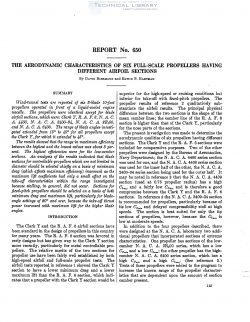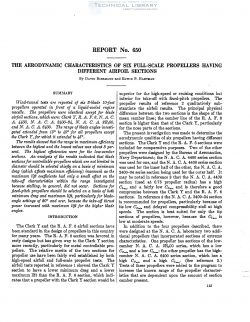naca-report-650

- Version
- 308 Downloads
- 2.15 MB File Size
- 1 File Count
- August 30, 2016 Create Date
- August 30, 2016 Last Updated
National Advisory Committee for Aeronautics, Report - The Aerodynamic Characteristics of Six Full Scale Propellers Having Different Airfoil Sections

The Clark Y and the R. A. F. 6 airfoil sections have
been standard in the design of propellers in this country
for many years. The R. A. F. 6 section was favored in
early designs but has given way to the Clark Y section
more recently, particularly for metal controllable pro-
pellers. The relative merits of the two sections for
propeller use have been fairly well established by both
high-speed airfoil and full-scale propeller tests. The
airfoil tests reported in reference 1 showed the Clark Y
section to have a lower minimum drag and a lower
maximum lift than the R. A. F. 6 section, which indi-
cates that a propeller with the Clark Y section would be
superior for the high-speed or cruising conditions but
inferior for take-01f with fixed—pitch propellers. The
propeller results of reference 2 qualitatively sub-
stantiate the airfoil results. The principal physical
difference between the two sections is the shape of the
mean camber lines; the camber line of the R. A. F. 6
section is higher than that of the Clark Y, particularly
for the nose parts of the sections.
The present investigation was made to determine the
aerodynamic qualities of six propellers having different
sections. The Clark Y and the R. A. F. 6 sections were
included for comparative purposes. Two of the other
propellers were designed by the Bureau of Aeronautics,
Navy Department; the N. A. C. A. '4400 series section
was used for one, and the N. A. C. A. 4400 series section
was used for the inner half of the other, the N. A. C. A.
2400—34 series section being used for the outer half. It
may be noted in reference 3 that the N. A. C. A. 4409
section (used at 0.75 propeller radius) has a high
0;,“ and a fairly low 09,,,. and is therefore a good
compromise between the Clark Y and the R. A. F. 6
sections. In reference 4 the N. A. C. A. 2409-34 section
is recommended for propellers, particularly because of
its low 09,“, and delayed compressibility stall at high
speeds. The section is best suited for only the tip
sections of propellers, however, because the 0,,” is
low at moderate speeds.
| File | Action |
|---|---|
| naca-report-650 The Aerodynamic Characteristics of Six Full Scale Propellers Having Different Airfoil Sections.pdf | Download |
Comment On This Post